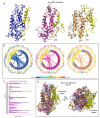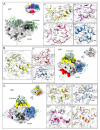In Silico Analysis of the Antagonist Effect of Enoxaparin on the ApoE4-Amyloid-Beta (A β) Complex at Different pH Conditions
- PMID: 35454088
- PMCID: PMC9027285
- DOI: 10.3390/biom12040499
In Silico Analysis of the Antagonist Effect of Enoxaparin on the ApoE4-Amyloid-Beta (A β) Complex at Different pH Conditions
Abstract
Apolipoprotein E4 (ApoE4) is thought to increase the risk of developing Alzheimer's disease. Several studies have shown that ApoE4-Amyloid β (Aβ) interactions can increment amyloid depositions in the brain and that this can be augmented at low pH values. On the other hand, experimental studies in transgenic mouse models have shown that treatment with enoxaparin significantly reduces cortical Aβ levels, as well as decreases the number of activated astrocytes around Aβ plaques. However, the interactions between enoxaparin and the ApoE4-Aβ proteins have been poorly explored. In this work, we combine molecular dynamics simulations, molecular docking, and binding free energy calculations to elucidate the molecular properties of the ApoE4-Aβ interactions and the competitive binding affinity of the enoxaparin on the ApoE4 binding sites. In addition, we investigated the effect of the environmental pH levels on those interactions. Our results showed that under different pH conditions, the closed form of the ApoE4 protein, in which the C-terminal domain folds into the protein, remains stabilized by a network of hydrogen bonds. This closed conformation allowed the generation of six different ApoE4-Aβ interaction sites, which were energetically favorable. Systems at pH5 and 6 showed the highest energetic affinity. The enoxaparin molecule was found to have a strong energetic affinity for ApoE4-interacting sites and thus can neutralize or disrupt ApoE4-Aβ complex formation.
Keywords: alzheimer disease; amyloid-β; apolipoprotein E; enoxaparin; molecular dynamics.
Conflict of interest statement
The authors declare no conflict of interest.
Figures









Similar articles
-
Quantification of molecular interactions between ApoE, amyloid-beta (Aβ) and laminin: Relevance to accumulation of Aβ in Alzheimer's disease.Biochim Biophys Acta. 2016 May;1862(5):1047-53. doi: 10.1016/j.bbadis.2015.08.025. Epub 2015 Aug 29. Biochim Biophys Acta. 2016. PMID: 26327683
-
Targeting of nonlipidated, aggregated apoE with antibodies inhibits amyloid accumulation.J Clin Invest. 2018 May 1;128(5):2144-2155. doi: 10.1172/JCI96429. Epub 2018 Mar 30. J Clin Invest. 2018. PMID: 29600961 Free PMC article.
-
High ability of apolipoprotein E4 to stabilize amyloid-β peptide oligomers, the pathological entities responsible for Alzheimer's disease.FASEB J. 2011 May;25(5):1585-95. doi: 10.1096/fj.10-175976. Epub 2011 Jan 25. FASEB J. 2011. PMID: 21266538
-
The nucleation growth and reversibility of Amyloid-beta deposition in vivo.J Alzheimers Dis. 2006 Nov;10(2-3):291-301. doi: 10.3233/jad-2006-102-313. J Alzheimers Dis. 2006. PMID: 17119294 Review.
-
Apolipoprotein E and oxidative stress in brain with relevance to Alzheimer's disease.Neurobiol Dis. 2020 May;138:104795. doi: 10.1016/j.nbd.2020.104795. Epub 2020 Feb 6. Neurobiol Dis. 2020. PMID: 32036033 Free PMC article. Review.
Cited by
-
Roles of ApoE4 on the Pathogenesis in Alzheimer's Disease and the Potential Therapeutic Approaches.Cell Mol Neurobiol. 2023 Oct;43(7):3115-3136. doi: 10.1007/s10571-023-01365-1. Epub 2023 May 25. Cell Mol Neurobiol. 2023. PMID: 37227619 Free PMC article. Review.
-
Study of the Rv1417 and Rv2617c Membrane Proteins and Their Interactions with Nicotine Derivatives as Potential Inhibitors of Erp Virulence-Associated Factor in Mycobacterium tuberculosis: An In Silico Approach.Biomolecules. 2023 Jan 28;13(2):248. doi: 10.3390/biom13020248. Biomolecules. 2023. PMID: 36830617 Free PMC article.
-
Pathophysiological Role of Microglial Activation Induced by Blood-Borne Proteins in Alzheimer's Disease.Biomedicines. 2023 May 7;11(5):1383. doi: 10.3390/biomedicines11051383. Biomedicines. 2023. PMID: 37239054 Free PMC article. Review.
References
Publication types
MeSH terms
Substances
LinkOut - more resources
Full Text Sources
Medical

